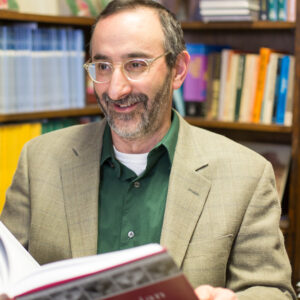Search Results
Back to JTS Torah Online's Main page
Living with the Divine Spirit
Mar 10, 2012 By Abigail Treu | Commentary | Ki Tissa
How to blame the Israelites for the Golden Calf episode, when it seems that all they want to do is create something holy?
Read More
Marketing Judaism
Feb 19, 2011 By Abigail Treu | Commentary | Text Study | Ki Tissa
If the Torah you teach isn’t sexy, don’t teach it. An unassailable marketing message rooted in a play on words: “had finished” is kekaloto, which─especially written as it is, missing the letter vav toward the end─could be rendered instead “as his bride.”
Read More
The Arab Spring and Ancient Israel
Feb 19, 2011 By Stephen P. Garfinkel | Commentary | Ki Tissa
What an amazing juxtaposition! The (near) miraculous events in Egypt that we witnessed on news broadcasts over the past week coincide with Parashat Ki Tissa, the Torah reading for this Shabbat. The circumstances of the two are wildly different, yet the fundamental human concerns in each setting overlap to an extraordinary degree.
Read More
The Dangers of Sacred Space
Mar 5, 2010 By Benjamin D. Sommer | Commentary | Ki Tissa
For more than a month during this time of year, we read about the mishkan, the Tabernacle, also called the ohel mo’ed, or Tent of Meeting. Parashiyot T’rumah and T’tzavveh, which we read the past two weeks, contain what amount to blueprints in prose format. These readings describe exactly how the Children of Israel in the wilderness of Sinai should construct the mishkan.
Read More
Moments of Intimacy with God
Mar 14, 2009 By Marc Wolf | Commentary | Ki Tissa | Purim
The unknown can be frightening. This week in particular, beyond the unknowns of the economic crisis that grips the world, we encounter insecurity in the Purim story, with God’s hand seemingly absent from directing the narrative. There is an uncertainty that the unknown breeds; we feel it deep within ourselves and struggle to overcome ambiguity through a search for assurance. What is and remains true is that the lesson of the day is consistent with the lesson of history—none of us is immune from the insecurity of the unknown. Even Moshe.
Read More
Listening: The Cornerstone of Leadership
Feb 23, 2008 By Charles Savenor | Commentary | Ki Tissa
In this week’s Torah portion, Ki Tissa, the Children of Israel stand at a crossroads between faith and fear, commitment and rebellion.
Read More
Actions with Consequences
Mar 10, 2007 By Matthew Berkowitz | Commentary | Ki Tissa
The Second Book of Samuel 12 is home to one of the most disturbing episodes of Tanakh. After King David’s reckless encounter with Batsheva and the murder of Uriah the Hittite, Nathan the prophet is sent by God to rebuke David. Nathan speaks in a biting metaphor, leading David in the direction of seeing himself as the guilty party of the parable. And just as Nathan concludes his story, he points his finger at David — informing David of his punishment: the sword will forever plague his household. What becomes shocking, though, is not the punishment that devolves on the shoulders of David, but rather the tragic end to the offspring of David and Batsheva.
Read More
Continuing Our Ancestors’ Debate with God
Mar 9, 2007 By Stephen P. Garfinkel | Commentary | Ki Tissa
Location, location, location! That’s not only a mantra in real estate but is also, as we shall see, an essential component in understanding some key elements of Ki Tissa, this week’s Torah reading.
Read More
A Radiant Face
Mar 18, 2006 By Matthew Berkowitz | Commentary | Ki Tissa
Coverings, especially of the face, are the theme of the hour in the Jewish calendar. The opening of this week began with our celebration of Purim. At the core of the holiday is the notion of hiddenness. God never explicitly appears in the entire ten chapters of the megillah; and the holiday is celebrated through festive costumes in which we mask, or cover, our true selves. This notion of covering continues thematically in this week’s Torah reading, Parashat Ki Tissa.
Read More
The Key to Salvation
Feb 26, 2005 By Ismar Schorsch | Commentary | Ki Tissa
The jarring truth about the episode of the golden calf is that it occurred at Mount Sinai.
Read More
The Polarities of Judaism
Apr 13, 2004 By Ismar Schorsch | Commentary | Ki Tissa | Shabbat Parah
The instructions of God to Moses concerning the building of the Tabernacle culminate with the command to observe the Sabbath. Holiness in time follows holiness in space. As the Tabernacle constitutes a sacred space in which the nearness of God is a felt experience, so the Sabbath is a portion of the week set apart to admit God into our lives. Whereas the holiness of the Sanctuary is sharply delimited and restricted in access, that of Shabbat is universally accessible. The Tabernacle is a public space, the community’s link between heaven and earth, administered by a priestly hierarchy and subject to laws of purity.
Read More
Listening to Anger
Mar 13, 2004 By Matthew Berkowitz | Commentary | Ki Tissa
Anger is a powerful emotion – propelling us toward constructive or destructive ends. The path to either of the latter however is chosen immediately in the aftermath of our fury. Will we simply be reactive in the moment and allow our wrath the power it seeks? Or will we rise above ourselves in an attempt to be self differentiated – to see the larger picture – and then act in a rational way? It is a moment pregnant with possibility. i.
Read More
Bodies in Mirrors
Mar 1, 2003 By Lauren Eichler Berkun | Commentary | Ki Tissa
In the midst of an elaborate description of Bezalel’s artistic crafting of the Tabernacle, we read an unusual detail: “He made the laver of copper and its stand of copper, from the mirrors of the women who performed tasks at the entrance of the Tent of Meeting” (Ex. 38:8). This copper laver served as a basin for cleansing waters so that the priests could enter the Tabernacle in a state of ritual purity. Why would Bezalel craft such an important vessel from women’s mirrors? Why does the Torah mention this specific detail?
Read More
The Spirituality of Kafka’s Doll
Feb 22, 2003 By Ismar Schorsch | Commentary | Ki Tissa
The story is told about Franz Kafka that the last time he visited Berlin, he chanced upon a little girl in a park awash in tears. When he inquired as to the reason for her distress, she sobbed that she had lost her doll. Compassionately, Kafka countered that not to be the case. The doll had merely gone on a trip and, in fact, Kafka met her as she was about to leave. He promised that if the little girl would return to the park the next day, he would bring her a letter from her doll. And so Kafka did for several weeks, arriving each morning at the park with a letter for his new friend.
Read More
Creation and Creativity
Feb 22, 2003 By Matthew Berkowitz | Commentary | Ki Tissa
When you sit down to center a piece of clay on the wheel, the first thing you must do is ‘center’ yourself — take a deep breath, let go of all extraneous thoughts, surrender control. You cannot force the clay into position with your hands or arms; rather, the message must emanate from your intellectual and emotional faculties: be quiet, be centered, be calm. To this, the clay responds.
Read More
Transcending “Soulless Piety”
Mar 2, 2002 By Ismar Schorsch | Commentary | Ki Tissa
Writing in the week of my father’s yahrzeit, I am drawn to reflect again on some of the spiritual heirlooms he left behind. One of my favorites is the piquant term “soulless piety” which he coined to describe an all too common phenomenon that results when ritual observance loses its emotional charge and we find ourselves just going through the motions. Judaism is a religion predicated on behavior rather than belief; compliance outranks spontaneity in its scale of values.
Read More
Two Cows
Mar 2, 2002 By Lauren Eichler Berkun | Commentary | Ki Tissa | Shabbat Parah
There is a certain irony when parashat Ki Tissa falls on Shabbat Parah. In our weekly Torah portion, we read about the sin of the golden calf. In the maftir for this special Shabbat preceding Passover, we read about the ritual of the red heifer. Two cows on one Shabbat! One cow represents our complete abandonment of God a mere forty days after the revelation at Mt. Sinai. The other cow represents our ability to purify ourselves in the face of death and defilement.
Read More
How Close Is God?
Feb 17, 2001 By Ismar Schorsch | Commentary | Ki Tissa
From his first encounter with God at the burning bush, Moses displayed a penchant for deep knowledge. He needed to comprehend God before he was ready to face Israel and Pharaoh. He demanded to know God’s name, the key to God’s being. This week again, after the debacle of the Golden Calf, Moses returns for more illumination. To be chosen requires understanding the chooser.
Read More
Shabbat: A Temple in Time
Feb 26, 2000 By Ismar Schorsch | Commentary | Ki Tissa
If “seeing is believing,” the converse of that adage is surely “out of sight out of mind.” There is something fragile about a faith predicated on sight. Remove its visible attendants and it soon collapses. What did Shakespeare say of another human state? “Love is not love which alters when it alteration finds, or bends with the remover to remove.” Constancy in love or faith soars above the transient.
Read More
What Did We Receive at Sinai?
Mar 14, 1998 By Ismar Schorsch | Commentary | Ki Tissa
At the end of the Torah reading in the synagogue, the scroll is spread and lifted so that everyone might see its hand-written script. Simultaneously, the congregation affirms out loud: “This is the Torah that Moses set before the people Israel; the Torah given by God, through Moses” (a composite of two verses, Deuteronomy 4:44 and a phrase repeated several times in the book of Numbers, 4:37,45; 9:23; 10:13). Having just finished a liturgical reenactment of the original national experience at Mount Sinai, we declare the text of this scroll to be the repository of that revelation.
Read MoreSUBSCRIBE TO TORAH FROM JTS
Our regular commentaries and videos are a great way to stay intellectually and spiritually engaged with Jewish thought and wisdom.




